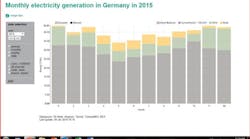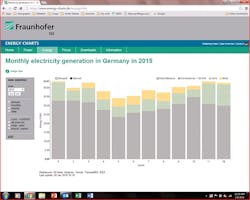The question of climate change isn’t if there’s change, but rather what and who is causing it. That question will be debated ad nausea without any real resolve as it’s not largely not a scientific debate anymore, but rather all political, even within the halls of science.
The telltale on the futility of the U.S. effort to solve the climate change problem lies with a quote that came from the Paris conference by Secretary of State Kerry when he stated:“The fact is that even if every American citizen biked to work, carpooled to school, used only solar panels to power their homes, if we each planted a dozen trees, if we somehow eliminated all of our domestic greenhouse gas emissions, guess what – that still wouldn’t be enough to offset the carbon pollution coming from the rest of the world.
If all the industrial nations went down to zero emissions – remember what I just said, all the industrial emissions went down to zero emissions – it wouldn’t be enough, not when more than 65% of the world’s carbon pollution comes from the developing world.”
The political aspect of the whole argument seems to center around not an environmental concern or interest, but rather purely a financial one. The environmental aspect is simply the means to an alternative end; one can probably easily derive why an issue like climate works well as a means to such an end as people are often hesitant to part with their wealth at will, yet saving the world in which they live is something that most would find quite appealing. The scope of the redistribution of financial wealth aspect of this whole matter can be seen in many aspects:
As the scale of international climate finance needed above and beyond current flows requires the re-direction of hundreds of billions of dollars annually, public finance from developed countries plays a key rolein leveraging the much larger flow of private finance attracted to investments in the energy sector. Public finance can assist in setting the direction for private investment, helping to channel it towards climate projects, such as renewable energy production, and away from investments in fossil fuel infrastructure. (Source: The Road Through Paris.)So if one is to believe Secretary Kerry’s comment about 65% of the pollution comes from the developing world, the above would question the ability to reform or change this matter, even with the vast amounts of monies promised through the Paris agreement, what with the adaption part of the equation largely being ignored. And that’s all hinged on the premise that it is mankind that is in fact causing global climate change. This is probably the fear that strikes the heart of those so adamantly pursuing the climate change decree, i.e. allowing science to truly and independently determine if the cause of climate change can be identified.
While the argument for climate change caused by humans consistently references a statement akin to ‘97% of scientists agree,’ that argument has been debunked many times by many different entities as being a gross misrepresentation of the scientific community at best. Additionally, much has been written of the fight for research monies by institutions and researchers, and how those monies are limited to only those with an intent or promise that their research will support the foregone position on man-caused climate change, to the point that institutions and/or researchers have had research monies pulled from them if they in fact they fail to provide the politically correct research answer (Sources: Forbes, Climate Depot and The Wall Street Journal). It’s troubling to see that research is not above being bought, or worse, threatened with funding.
It’s most interesting to watch the industry response to the matter; surely there is a diversity of reactions, varying from wholly supporting the current administrations direction to staunchly decrying it. What I find most interesting is how those wholly supporting him often are realizing significant financial gain by doing so, through such means as earmarked funding for ‘research’ or ‘demonstration’ projects, with those funds going directly to them or a wholly-owned subsidiary, or other more direct means such as tax incentives.
There was a recent report where some in the industry are taking a much different approach to the newly proposed CPP rules and regulations, stating it’s not their responsibility to protect their fuel source industries (i.e., coal and gas), but rather the states from where these natural resources are mined. That really poses a much broader question on the issue: Just what is the role of the power generation industry in this whole matter? For those who might be left with untold stranded investments in technologies that might be mothballed far before their depreciated life, who will bear those financial costs?
Likewise, while no one argues that the cost of renewable energy power generation has declined significantly, it surely must remain beyond the realm of being financially viable to develop or there wouldn’t be such a clamor for the extension of all the financial incentives that this assignment references were just granted by Congress. Truth be told, while there are numerous stories of ‘sold-out’ solar communities these days, there are also examples where those projects are not selling to the general public. The difference being the latter are not subsidized to a point that makes the investment feasible; those non-subsidized projects with 25- to 30-year paybacks just don’t make much financial sense to anyone who values their money. That begs the question: If American’s are hesitant make that type of investment, why should the government be so anxious to do so?
Likewise, many utilities that were so willing to offer net-metering interconnections to renewable energy production are now realizing the Pandora box they created and finding the attempts to close that door challenging at best. If renewable power generation was so affordable, why the need to net meter it? Again, many in the utility industry likely made decisions that appeared to be the politically correct answer only to find the decision was not feasible, and are now left to solve the unsolvable puzzle they created.
The fact of the matter remains that until research can overcome the energy density and storage challenge that haunts renewable energy generation, it will continue to struggle to gain ground against the use of fossil fuel, unless the latter is so hampered by law and regulation so as to make it unaffordable. Renewable enthusiasts often point to Germany as the great success story for renewables. If one looks at their power generation portfolio for 2014, wind and solar still account for less than 15% of their energy production (Source: ENS) while tradition power sources - coal, gas and nuclear - supply almost 70%.
Data for 2015 doesn’t differ much:
While Germany works to switch its energy production to a more renewable-based source, their energy pricing continues to lead the world although some would argue the relative price is on the decline; that may well be more the result of the policy effect on conventional generation power sources vs. the market effect.
A large base of the current fleet of U.S. coal-fired production was built on (1970s) government directive at a time when oil was a challenging commodity:
Federal policies moved in coal's favor in the 1970s. With the Middle East oil crisis, policymakers began to adopt policies to try and shift the nation toward greater coal consumption, which was a domestic energy resource. The Energy Supply and Environmental Coordination Act of 1974 directed the Federal Energy Administration to prohibit the use of oil or natural gas by electric utilities that could use coal, and it authorized the FEA to require that new electric power plants be able to use coal. The Energy Policy and Conservation Act of 1975 extended those powers for two years and authorized $750 million in loan guarantees for new underground low-sulfur mines. Further pro-coal mandates were passed in the late-1970s. (Source: Downsizing the Government)
If the government continues to penalize the use of fossil fuels as a generation power source, the industry will be forced to find an alternative energy to power the nation. It simply defies common logic that present technology will support wind and/or solar power generation to the levels that can adequately, reliably and affordably meet the country’s expectations. Already there are numerous instances where the mere talk of siting large-scale renewable energy projects are being soundly rejected with a NIMBY mentality. The renewable energy footprint required to achieve anything resembling a significant replacement portion of the current fleet of fossil fuel energy production is simply not understood by the general public. If the public were told the truth as to just what that footprint would entail, how much land would be required to host that level or renewable energy production (in those areas where renewable energy production is logical), one has to wonder what the public reaction would be; arguably it may well be far less than enthusiastic.
Thus, I believe today’s renewable energy market is being driven somewhat by those people (a very small minority) with good intentions to do their small part to solve what they believe is a problem (arguably to be proven), while a much larger (significantly larger) percentage of people and/or businesses that are delving into these areas are doing so primarily for the financial gain afforded them by being savvy to the available financial incentives while also being very politically correct, and have little if any interest in the environmental aspects. If it were not for the financial incentives, I truly believe they would be very quick to redirect their investments to a much different investment portfolio.
Thus, if the attempt is made to enact a wholesale change within America toward renewable energy through the likes of the current administration’s CPP, there are three significant hurdles that must be overcome:
- Who will pay for the new fleet of renewable energy projects?
- What fuel source will be used to provide the backup power generation when the renewable resources fall short of meeting the power demands, and who will pay for those investments?
- Who will pay for the stranded investment costs of the shuttered fleet of power plants that are not yet paid for?
The logical answer to all of the above is probably the American public. However, I do not believe they have any idea what those costs will be, and when faced with them, will cry out in pain and disbelief, asking (the electric utility industry?) how this came to be. The utility industry is definitely not unified at the present time with any type of position on this matter, which leaves the country with a somewhat alarming situation.





